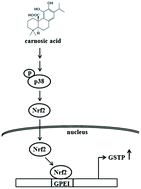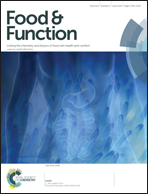Induction of the pi class of glutathione S-transferase by carnosic acid in rat Clone 9 cells via the p38/Nrf2 pathway
Abstract
Induction of phase II enzymes is important in cancer chemoprevention. We compared the effect of rosemary diterpenes on the expression of the pi class of glutathione S-transferase (GSTP) in rat liver Clone 9 cells and the signaling pathways involved. Culturing cells with 1, 5, 10, or 20 μM carnosic acid (CA) or carnosol (CS) for 24 h in a dose-dependent manner increased the GSTP expression. CA was more potent than CS. The RNA level and the enzyme activity of GSTP were also enhanced by CA treatment. Treatment with 10 μM CA highly induced the reporter activity of the enhancer element GPEI. Furthermore, CA markedly increased the translocation of nuclear factor erythroid-2 related factor 2 (Nrf2) from the cytosol to the nucleus after 30 to 60 min. CA the stimulated the protein induction of p38, nuclear Nrf2, and GSTP was diminished in the presence of SB203580 (a p38 inhibitor). In addition, SB203580 pretreatment or silencing of Nrf2 by siRNA suppressed the CA-induced GPEI-DNA binding activity and GSTP protein expression. Knockdown of p38 or Nrf2 by siRNA abolished the activation of p38 and Nrf2 as well as the protein induction and enzyme activity of GSTP by CA. These results suggest that CA up-regulates the expression and enzyme activity of GSTP via the p38/Nrf2/GPEI pathway.


 Please wait while we load your content...
Please wait while we load your content...